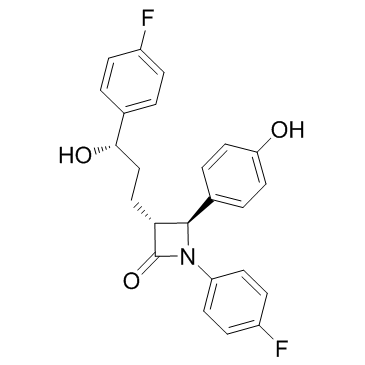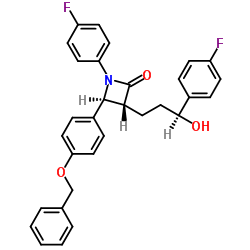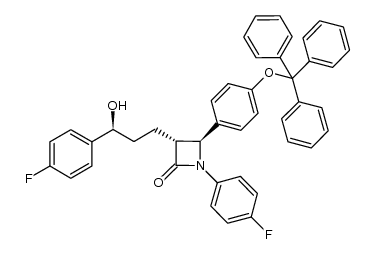163222-33-1
| Name | ezetimibe |
|---|---|
| Synonyms |
Ezetimide
Zetia EzitiMibeEzetiMibeC24H21F2N03 Ezetrol (3R,4S)-1-(4-fluorophényl)-3-[(3S)-3-(4-fluorophényl)-3-hydroxypropyl]-4-(4-hydroxyphényl)azétidin-2-one Int (3R,4S)-1-(4-Fluorophenyl)-3-[(3S)-3-(4-fluorophenyl)-3-hydroxypropyl]-4-(4-hydroxyphenyl)-2-azetidinone ezetimibe EzetiMib (3R,4S)-1-(4-fluorophenyl)-3-[(3S)-3-(4-fluorophenyl)-3-hydroxypropyl]-4-(4-hydroxyphenyl)azetidin-2-one (3R,4S)-1-(4-Fluorphenyl)-3-[(3S)-3-(4-fluorphenyl)-3-hydroxypropyl]-4-(4-hydroxyphenyl)azetidin-2-on MFCD00937872 |
| Description | Ezetimibe (SCH 58235) is a Niemann-Pick C1-like1 (NPC1L1) inhibitor, and is a potent Nrf2 activator. Ezetimibe (SCH 58235) is a potent cholesterol absorption inhibitor. |
|---|---|
| Related Catalog | |
| Target |
NPC1L1, Nrf2[1] |
| In Vitro | Ezetimibe (Eze) acts as a potent Nrf2 activator without causing cytotoxicity. Ezetimibe enhances transactivation of Nrf2, as revealed by a luciferase reporter assay. Ezetimibe also upregulates Nrf2 target genes, including GSTA1, heme oxygenase-1 (HO-1) and Nqo-1 in Hepa1c1c7 and MEF cells. Ezetimibe upregulates Nrf2 target genes in Nrf2+/+ MEF cells, whereas this induction is totally blocked in Nrf2-/- MEF cells. Taken together, Ezetimibe acts as a novel Nrf2 inducer in a ROS-independent manner[1]. Human huh7 hepatocytes are pretreated with Ezetimibe (10 μM, 1 h) and incubated with palmitic acid (PA, 0.5 mM, 24 h) to induce hepatic steatosis. Ezetimibe treatment significantly attenuates PA-increased triglycerides (TG) levels, which is consistent with our animal study. PA treatment resulted in an approximately 20% decrease in mRNA expression of ATG5, ATG6, and ATG7, which had been increased by Ezetimibe treatment. In addition, Ezetimibe treatment significantly increased the PA-induced reduction in LC3 protein abundance[2]. |
| In Vivo | Administration of Ezetimibe (Eze) reduces the liver weights of mice fed the methionine- and choline-deficient (MCD) diet. This is consistent with the beneficial effects of Ezetimibe on hepatic steatosis. Liver histology shows pronounced multiple macrovesicular fat droplets in mice on the MCD diet, but Ezetimibe treatment markedly decreases the number and size of those droplets. Furthermore, hepatic fibrosis in mice fed the MCD diet is significantly attenuated by Ezetimibe[1]. Blood and liver lipid levels including TG, free fatty acids (FFA), and total cholesterol (TC) are significantly decreased in Ezetimibe-treated OLETF rats. Moreover, OLETF rats show higher serum levels of glucose, insulin, HOMA-IR, TG, FFA, and TC than LETF animals, which are significantly reduced by Ezetimibe. In addition, histological analysis indicated that OLETF control rats showed larger lipid droplets in hepatocytes than age-matched LETO controls, which are attenuated by administration of Ezetimibe[2]. |
| Kinase Assay | GST-p62 is prepared from Escherichia coli and 0.5 μg of the purified GST-p62 protein is used for in vitro AMPK phosphorylation assay. Phosphorylation of p62 protein by AMPK is determined by non-radioisotope method using γS-ATP. AMPK complex is immuno-purified from the HEK293 cells, to which either myc-AMPKα1 wild-type (WT) or myc-AMPKα1 kinase-dead mutant (KD, D157A) is transfected with Flag-AMPKβ1 and HA-AMPKγ1. AMPK complex is added into the reaction mixture containing 20 mM HEPES, pH7.4, 1 mM EGTA, 0.4 mM EDTA, 5 mM MgCl2, 0.05 mM DTT, 0.5 μg GST-p62, 0.2 mM AMP, and 1 mM ATPγS. Reaction is carried out at 37°C for 30 min, and then terminated by adding 20 mM EDTA. To detect γS-labeled p62 protein, the reaction product is alkylated with 2.5 mM PNBM for 2 h at room temperature and analyzed the products by western blotting using anti-thiophosphate antibody[1]. |
| Cell Assay | Huh7 human hepatocytes are cultured in high glucose DMEM containing 10% FBS, 100 units/mL penicillin and 100 μg/mL streptomycin at 37°C in a 95% air/5% CO2 atmosphere. Hepatocytes are treated with or without Ezetimibe (10 μM, 1 h) and incubated with palmitic acid (PA, 0.5 mM, 24 h)[2]. |
| Animal Admin | Mice[1] Ten-week-old C57BL/6J male mice are used. These animals are randomly assigned to one of three groups (7-10 mice in each group): normal chow diet; MCD diet, vehicle-treated; or MCD diet, Ezetimibe -treated. The mice had free access to diet and water, with temperature maintained at 23±2°C, humidity of 60%±10%, and 12-h light/dark cycles. In the MCD diet with Ezetimibe group, Ezetimibe 10 mg/kg is given once daily by oral gavage for 4 weeks. The chow and MCD diet with vehicle groups received the same volume of phosphate buffered saline orally for 4 weeks. Body weight is measured once a week over the course of the treatment period. After 4 weeks, the mice are anesthetized and killed; blood is collected via heart puncture. Tissues are harvested and either snap-frozen in liquid nitrogen and stored at −70°C or fixed in formalin and embedded in paraffin. Rats[2] Male OLETF (n=11) and age-matched LETO rats (n=3) are used, and experiments are conducted in a specific pathogen-free facility with a 12 h light/dark cycle. The OLETF rat is a model that represents late-onset hyperglycemia and exhibits a chronic disease course, mild obesity and clinical onset of diabetes mellitus. Animals have unrestricted access to water and food. At 12 wk of age, rats are randomized and treated with either PBS or Ezetimibe (10 mg/kg per day) via a stomach gavage for 20 wk. At the end of the study, the rats are fasted overnight and anesthetized with intraperitoneal Zoletil/Rompun. Blood is collected from the abdominal aorta, and liver tissues are dissected, immediately frozen in liquid nitrogen, and stored at -80°C until further analysis. |
| References |
| Density | 1.3±0.1 g/cm3 |
|---|---|
| Boiling Point | 654.9±55.0 °C at 760 mmHg |
| Melting Point | 164-166℃ |
| Molecular Formula | C24H21F2NO3 |
| Molecular Weight | 409.425 |
| Flash Point | 349.9±31.5 °C |
| Exact Mass | 409.148956 |
| PSA | 60.77000 |
| LogP | 3.26 |
| Vapour Pressure | 0.0±2.1 mmHg at 25°C |
| Index of Refraction | 1.624 |
| Storage condition | -20?C Freezer |
| Risk Phrases | 36/37/38 |
|---|---|
| Safety Phrases | 26-36 |
| RIDADR | NONH for all modes of transport |
| HS Code | 2934999090 |
| Precursor 7 | |
|---|---|
| DownStream 1 | |
| HS Code | 2934999090 |
|---|---|
| Summary | 2934999090. other heterocyclic compounds. VAT:17.0%. Tax rebate rate:13.0%. . MFN tariff:6.5%. General tariff:20.0% |



![(3R,4S)-4-[4-(Benzyloxy)phenyl]-1-(4-fluorophenyl)-3-[3-(4-fluorophenyl)-3-oxopropyl]azetidin-2-one structure](https://image.chemsrc.com/caspic/474/190595-65-4.png)

![3-{2-[3-(fluorophenyl)-3-(trimethyl silyloxy)-propyl]-3-(4-fluoro phenyl amino)-3-(4-trimethyl silyloxy phenyl)-1-oxo-propyl}-4-(S)-phenyl oxazolidin-2-one structure](https://image.chemsrc.com/caspic/438/858126-22-4.png)
![2-Azetidinone, 4-[4-[[(1,1-dimethylethyl)dimethylsilyl]oxy]phenyl]-1-(4-fluorophenyl)-3-[(3S)-3-(4-fluorophenyl)-3-hydroxypropyl]-, (3R,4S) structure](https://image.chemsrc.com/caspic/061/942485-60-1.png)
![(3R,4S)-1-(4-fluorophenyl)-3-[(3S)-3-(4-fluorophenyl)-3-hydroxypropyl]-4-[4-(4,4,5,5-tetramethyl-1,3,2-dioxaborolan-2-yl)phenyl]azetidin-2-one structure](https://image.chemsrc.com/caspic/330/1004520-48-2.png)
![[4-[(2S,3R)-3-[(3R)-3-acetyloxy-3-(4-fluorophenyl)propyl]-1-(4-fluorophenyl)-4-oxoazetidin-2-yl]phenyl] acetate structure](https://image.chemsrc.com/caspic/122/163380-20-9.png)